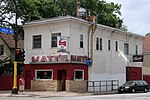Minneapolis Pioneers and Soldiers Memorial Cemetery

The Minneapolis Pioneers and Soldiers Memorial Cemetery is the oldest extant cemetery in Minneapolis, Minnesota, United States. It was established in 1858 as a privately owned burial ground known as Minneapolis Cemetery or Layman's Cemetery. By 1919 it was full, with more than 27,000 bodies, and was closed by the city government. Only a handful of burials have taken place there since.The cemetery is located at the intersection of Lake Street and Cedar Avenue. Since the first burial in 1853 the cemetery has been the final resting place of those who helped shape the history of early Minneapolis. Several prominent territorial pioneers, including Charles Christmas, Edwin Hedderly, and Philander Prescott are buried there. Approximately 200 military veterans who fought in wars ranging from the War of 1812 to World War I are buried in the cemetery. It is the burial site for many of the city's early African-American residents and for many people who had ties to the abolitionist movement in Minnesota. Several thousand immigrants, primarily from Scandinavia and Eastern Europe, are buried there, as are many of their children. Over half of the cemetery's 20,000 interments are children.The cemetery was listed on the National Register of Historic Places in 2002 for its local significance in the theme of social history. It was nominated for reflecting both the city's pioneer era and an early historic preservation movement that saw the site restored from 1928 to 1936.
Excerpt from the Wikipedia article Minneapolis Pioneers and Soldiers Memorial Cemetery (License: CC BY-SA 3.0, Authors, Images).Minneapolis Pioneers and Soldiers Memorial Cemetery
20th Avenue South, Minneapolis
Geographical coordinates (GPS) Address Nearby Places Show on map
Geographical coordinates (GPS)
| Latitude | Longitude |
|---|---|
| N 44.949444444444 ° | E -93.245 ° |
Address
South Transfer Station
20th Avenue South 2850
55407 Minneapolis
Minnesota, United States
Open on Google Maps






